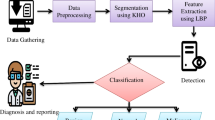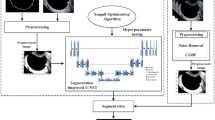Abstract
Ovaries are important parts of the female reproductive system because they produce the egg or ovum needed for fertilization. Cysts frequently impact female follicles, so torsion, infertility, and cancer can result from an enormous ovarian cyst. As a result, this is critical to get a diagnosis as quickly as feasible an ultrasound examination is performed to diagnose an ovarian cyst. So, this work gathered ultrasound images of different women's ovaries and determined whether or not an ovarian cyst was detected. This work proposed a novel technique to detect the ovarian cyst using images of ovarian ultrasound cysts from an ongoing database. Initially pre-processed by removing noise, followed by feature extraction, and finally classifying using new deep reinforcement learning with Harris Hawks Optimization (HHO) classifier. Automatic feature extraction is implemented using the recent popular convolutional neural network (CNN) technique that extracts image features as conditions in the reinforcement learning algorithm. Deep Q-Network (DQN) is generated to train a Q-network and detect the disease, and the swarm-based method of HHO utilizes the optimization method to produce optimal hyperparameters in the DQN model known as HHO-DQN. Extensive experimental evaluations on datasets show that the proposed HHO- DQN approach outperforms existing active learning approaches for ovarian cyst classification.











Similar content being viewed by others
Availability of data and materials
The authors confirm that the data supporting the findings of this research are available within the article.
Code availability
Custom code.
References
Rathore R, Sharma S, Arora D (2017) Clinicopathological evaluation of 223 cases of mature cystic Teratoma, ovary: 25-year experience in a single tertiary care centre in India. J Clin Diagn Res: JCDR 11(4):EC11
Li Z, Zhang X, Müller H, Zhang S (2018) Large-scale retrieval for medical image analytics: a comprehensive review. Med Image Anal 43:66–84
Sohail ASM., Bhattacharya P, Mudur SP, Krishnamurthy S, Gilbert L (2010) Content-based retrieval and classification of ultrasound medical images of ovarian cysts. Artif Neural Netw Pattern Recogn 173–184
Bascietto F, Liberati M, Marrone L, Khalil A, Pagani G, Gustapane S et al (2017) Outcome of fetal ovarian cysts diagnosed on prenatal ultrasound examination: systematic review and meta-analysis. Ultrasound Obstet Gynecol 50(1):20–31
Acharya UR, Sree SV, Saba L, Molinari F, Guerriero S, Suri JS (2013) Ovarian tumor characterization and classification using ultrasound—a new online paradigm. J Digit Imaging 26(3):544–553
Oroojlooyjadid A, Nazari M, Snyder LV, Takáč M (2021) A deep Q-network for the beer game: deep reinforcement learning for inventory optimization. Manuf Serv Oper Manag
Tajima A, Suzuki C, Kikuchi I, Kasahara H, Koizumi A, Nojima M, Yoshida K (2016) Efficacy of the echo pattern classification of ovarian tumors 2000 in conjunction with transvaginal ultrasonography for diagnosis of ovarian masses. J Med Ultrason 43(2):249–255
D’Angelo E, Prat J (2010) Classification of ovarian carcinomas based on pathology and molecular genetics. Clin Transl Oncol 12(12):783–787
Foti PV, Attinà G, Spadola S, Caltabiano R, Farina R, Palmucci S et al (2016) MR imaging of ovarian masses: classification and differential diagnosis. Insights Imaging 7(1):21–41
Srivastava S, Kumar P, Chaudhry V, Singh A (2020) Detection of ovarian cyst in ultrasound images using fine-tuned VGG-16 deep learning network. SN Comput Sci 1(2):1–8
Wu M, Yan C, Liu H, Liu Q (2018) Automatic classification of ovarian cancer types from cytological images using deep convolutional neural networks. Biosci Rep 38(3):BSR20180289. https://doi.org/10.1042/BSR20180289
Wu C, Wang Y, Wang F (2018) Deep learning for ovarian tumor classification with ultrasound images. In: Pacific Rim conference on multimedia. Springer, Cham, pp 395–406
Rahman MA, Muniyandi RC, Islam KT, Rahman MM (2019) Ovarian cancer classification accuracy analysis using 15-neuron artificial neural networks model. In: 2019 IEEE Student Conference on Research and Development (SCOReD). IEEE, pp 33–38
Available from: Ovarian Cancer Ultrasound Stock Photos, Images & Royalty-Free Images - iStock (istockphoto.com)
Cornelis B, Moonen M, Wouters J (2010) Performance analysis of multichannel Wiener filter-based noise reduction in hearing aids under second order statistics estimation errors. IEEE Trans Audio Speech Lang Process 19(5):1368–1381
Fan J, Wang Z, Xie Y, Yang Z (2020) A theoretical analysis of deep Q-learning. In: Learning for dynamics and control. PMLR, pp 486–489
Heidari AA, Mirjalili S, Faris H, Aljarah I, Mafarja M, Chen H (2019) Harris hawks optimization: algorithm and applications. Futur Gener Comput Syst 97:849–872
Wang Y, Liu H, Zheng W, Xia Y, Li Y, Chen P et al (2019) Multi-objective workflow scheduling with deep-Q-network-based multi-agent reinforcement learning. IEEE access 7:39974–39982
https://assets.researchsquare.com/files/rs-920250/v1_covered.pdf?c=1632776085
Acknowledgements
An earlier version of this work has been presented as a preprint by Research Square [19].
Funding
No.
Author information
Authors and Affiliations
Contributions
This article has six authors, and all contributed equally.
Corresponding author
Ethics declarations
Conflict of interest
The authors declare no conflict of interest, financial or otherwise.
Ethics approval
Not applicable.
Consent to participate
Not applicable.
Consent for publication
Not applicable.
Human and animal rights
No animals/humans were used for studies that are the basis of this research.
Additional information
Publisher's Note
Springer Nature remains neutral with regard to jurisdictional claims in published maps and institutional affiliations.
Rights and permissions
About this article
Cite this article
Narmatha, C., Manimegalai, P., Krishnadass, J. et al. Ovarian cysts classification using novel deep reinforcement learning with Harris Hawks Optimization method. J Supercomput 79, 1374–1397 (2023). https://doi.org/10.1007/s11227-022-04709-8
Accepted:
Published:
Issue Date:
DOI: https://doi.org/10.1007/s11227-022-04709-8




